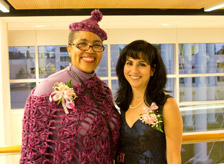“My medical oncologist may have saved my life.”‐Judi Blue
Since I was 35, my birthday gift to myself each year was receiving a mammogram. I began mammography screening when I was 35 when I learned I had fibrocystic breast disease, a noncancerous condition, and also because of a history of breast cancer in my family. Beginning that year I also had a copy of each mammogram sent to my gynecologist for further analysis.
In 2007, that extra vigilance paid off when my gynecologist noticed something suspicious even though the radiologist who took the first look at my images had not seen anything. My gynecologist referred me to a breast specialist who ordered an ultrasound, an ultrasound-guided core biopsy, and an MRI. The MRI confirmed that I had a cancerous lump in my breast.
The tumor was small but complex. About 80% was ductal carcinoma in situ, or DCIS, which can be malignant but does not spread beyond the milk ducts. The other 20% was invasive ductal carcinoma, which means it can spread. I was told that the prognosis was poor and that I should start treatment right away.

My mother had been treated for breast cancer in 1995 at Fox Chase Cancer Center, so I knew I wanted the same quality of care for myself. My first treatment was a lumpectomy performed at a partner hospital of Fox Chase located near my home. The surgeon also removed some surrounding lymph nodes and did a biopsy to make sure the cancer had not spread.
Next, I started chemotherapy with a medical oncologist at Fox Chase who was highly recommended by my radiologist at the partner hospital. My medical oncologist decided I should have chemotherapy every two weeks rather than every three, the schedule recommended by other hospitals. Having the chemotherapy more often may have been a life-saving decision; my medical oncologist may have saved my life.
I was very impressed with all the staff I met at Fox Chase. One nurse in particular, Karon Martyn, was extremely empathetic and caring, an incredible woman. I can’t imagine seeing people in this condition day after day and it not taking its toll on you. All of the nurses were amazing and compassionate. The nurses in the infusion room were so comforting and empathetic. It made the experience almost delightful.
After I finished chemotherapy, I returned to my local Fox Chase partner hospital for the last leg of my treatment, radiation therapy. Two years after I had completed radiation therapy in 2007, I noticed purple lesions near the lumpectomy scar. After several biopsies, an MRI, and monitoring for one full year, my doctors discovered more cancer. I underwent a mastectomy with reconstruction and returned to work six weeks later. It was the longest break from work I had ever taken for cancer treatment.
During my cancer therapy I developed an unusual and transformative hobby, one that helps me and others cope with cancer. A medical masseuse I had seen during my treatment called me in 2008 and said she remembered the hand-crocheted garments I made that I often wore and wondered if I would be interested in using my artistic abilities in another medium: painting. There was just one catch: I would use my breasts as a paintbrush.
At first I thought it was a strange request, but the masseuse wanted to raise money for breast cancer patients. I decided to give it a try, and the results were miraculous. It turned out to be a mode of art therapy that helped me heal from some deeper issues associated with breast cancer, ones that I could not otherwise express in words. It enabled me to delve deeper and create some sunshine on a rainy day for myself and others.
My first painting of that type sold at a gallery for $50 to a medical oncologist. I remember thinking if the painting had touched someone who was not sick, imagine what it could do for someone who was sick. Since that time, I have created original designs using this unique method and have distributed them whenever possible to others with cancer. I have put my designs on postcards, calendars, envelope openers, watches, purses, necklaces, and key chains, and I often accompany them with inspirational words. I distribute these keepsakes at breast cancer support groups and events and any time I hear that someone has been diagnosed.
I have so much to say to others because I know what I had to tell myself every day. Having breast cancer has really been a gift to me. It helped me turn something ugly into something beautiful. The message I want to communicate is that you are an extraordinary person, and that is why something extraordinary happened to you. You just have to think about it differently.